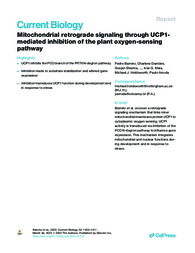Mitochondrial retrograde signaling through UCP1-mediated inhibition of the plant oxygen-sensing pathway.
Mitochondrial retrograde signaling through UCP1-mediated inhibition of the plant oxygen-sensing pathway.
Author(s): BARRETO, P.; DAMBIRE, C.; SHARMA, G.; VICENTE, J.; OSBORNE, R.; YASSITEPE, J. E. de C. T.; GIBBS, D. J.; MAIA, I. G.; HOLDSWORTH, M. J.; ARRUDA, P.
Summary: SUMMARY. Mitochondrial retrograde signaling is an important component of intracellular stress signaling in eukaryotes. UNCOUPLING PROTEIN (UCP)1 is an abundant plant inner-mitochondrial membrane protein with multiple functions including uncoupled respiration and amino-acid transport1,2 that influences broad abiotic stress responses. Although the mechanism(s) through which this retrograde function acts is unknown, overexpression of UCP1 activates expression of hypoxia (low oxygen)-associated nuclear genes.3,4 Here we show in Arabidopsis thaliana that UCP1 influences nuclear gene expression and physiological response by inhibiting the cytoplasmic PLANT CYSTEINE OXIDASE (PCO) branch of the PROTEOLYSIS (PRT)6 N-degron pathway, a major mechanism of oxygen and nitric oxide (NO) sensing.5 Overexpression of UCP1 (UCP1ox) resulted in the stabilization of an artificial PCO N-degron pathway substrate, and stability of this reporter protein was influenced by pharmacological interventions that control UCP1 activity. Hypoxia and salt-tolerant phenotypes observed in UCP1ox lines resembled those observed for the PRT6 N-recognin E3 ligase mutant prt6-1. Genetic analysis showed that UCP1 regulation of hypoxia responses required the activity of PCO N-degron pathway ETHYLENE RESPONSE FACTOR (ERF)VII substrates. Transcript expression analysis indicated that UCP1 regulation of hypoxia-related gene expression is a normal component of seedling development. Our results show that mitochondrial retrograde signaling represses the PCO N-degron pathway, enhancing substrate function, thus facilitating downstream stress responses. This work reveals a novel mechanism through which mitochondrial retrograde signaling influences nuclear response to hypoxia by inhibition of an ancient cytoplasmic pathway of eukaryotic oxygen sensing.
Publication year: 2022
Types of publication: Journal article
Observation
Some of Embrapa's publications are published as ePub files. To read them, use or download one of the following free software options to your computer or mobile device. Android: Google Play Books; IOS: iBooks; Windows and Linux: Calibre.
Access other publications
Access the Agricultural Research Database (BDPA) to consult Embrapa's full library collection and records.
Visit Embrapa Bookstore to purchase books and other publications sold by Embrapa.

